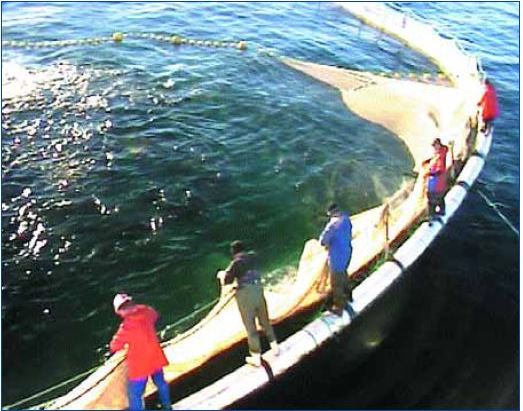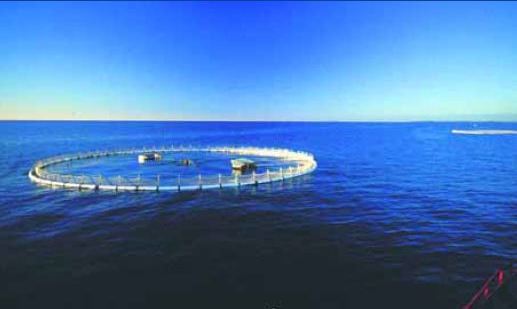Culture systems
The culture systems used in tuna capture-based aquaculture owe much to the development of the salmon industry. Offshore cage systems predominate for culture and towing operations. All those used have to be able to withstand rough sea conditions, and are some of the largest cages currently in used in mariculture.
Bluefin tuna capture-based aquaculture uses a similar culture system throughout the world (Figure 94), due to common fish behaviour and environmental requirements. Beaz (2003) states that a good tuna cage should be designed to be deep enough to allow normal tuna behaviour and to avoid the stress mortality caused by lightning during storms.
The cages are typically large (average diameter 30-50 m), to allow large tuna enough room for movement, and are floating (submersible cages are also being tested). The circumference of the cages are typically 150 m and the fish are usually stocked at densities of about 2-4 kg/m3. Some companies are now using much larger cages, with a circumference of about 270 m, giving a culture volume of 150 000 m3. There is already evidence mounting that the larger the cage, the better the fish quality (Agius 2002). Cages need to be moored in water that is of sufficient depth to allow good flow patterns beneath the cage, and so that any waste build-up beneath them cannot interact with the water within them. A minimum of 20 m clearance is recommended by Agius (2002).
Cages are usually made from high density polyethylene material which is flexible but at the same time strong enough. There are many versions. There are also cages which consist solely of nets with no surface collar (Agius 2002).

Figure 94. Tuna cage in Port Lincoln (South Australia) (Photo: L. Mittiga)
Good water quality is crucial for bluefin tuna, and suitable locations should exclude any possibility of turbidity caused by runoff or the stirring of benthic material. In Morocco, heavy storms caused a high number of deaths among bluefin tuna kept in a very large rearing cage: the gills of the fish were found to be clogged with mud, due to floods in the area (Mourente and Pascual 2002). Experience gained in tuna farming so far particularly emphasises the importance of choosing suitable locations, which should ensure that the open sea dominates the dynamics of the water column in which the cages are located, thus ensuring high transparency and high dissolved oxygen, which sustains the high physiological demand and continuous energetic swimming costs (Katavic, Vicina and Franicevic 2003a). Doumenge (1999) estimated that the optimum temperature for tuna is between 18 and 26°C, but tuna can also suffer from reduced salinity and the presence of suspended particulate matter.
Specific cage designs differ widely in the construction materials used, their mooring systems and the mesh size employed for the net. Some accounts of differing systems follow. In Morocco, fish are kept in 120 x 40 x 30 m floating net-cages moored in the open sea that has a depth of 55m (Nhhala 2002). Farms currently (2002) in operation in Malta stock their fish in a total of thirteen 45–60 m diameter offshore cages that are anchored 1 km off the coastline. The cages are high density polyethylene (HDPE) floating circular cages and are moored independently (Peric 2003b). In Croatia, cages are situated mainly along the eastern central Adriatic coast. The cage type developed in Australia, though slightly modified, is used for holding the fish: the floating circle cage has a diameter of 50 m and a net depth of 20 m (Katavic, Vicina and Franicevic 2003b;
Miyake et al. 2003). They are only partially anchored, and can be moved from one location to another. Bridgestone or Dunlop (rubber hoses) floating cages are used in Cartagena, Spain (Doumenge 1999). Old Japanese rectangular type of cages, about 70 x 40 m, anchored to the bottom of the sea, are used in Ceuta, Spain.
The tuna capture-based aquaculture industry in Australia uses twenty 20-30 ha lease sites (in 2002) in wave exposed waters from 1-10 km offshore in about 20 m water depth (Clarke 2002). 40 m diameter Polar-Cirkel HDPE cages are used, with a total volume of 15 000 m3 (Doumenge 1999). Since 1996, larger cages (with a diameter of 50 m) are in use, for a total volume of 20 000 m3. Mesh sizes vary between 55 mm to 70 mm (O’Sullivan 1993). In Amami O-shima (Japan), the cages rely on a buoy system that assures both floating and structural integrity. The cages are rectangular, 40 x 25 m but are only suitable for use in sheltered waters.
Turner (2002) believes that tuna capture-based aquaculture culture systems are in need of improvement. Engineering should focus on the construction of larger cages that are able to survive the offshore wave climate with very little maintenance, and that can be moored in very deep water. The basic technology for cage construction of this type exists and has been tested in Norway and other salmon producing nations; however the cost implications and maintenance of mooring systems for cages in very deep waters needs careful evaluation. Turner (2002) proposes solutions such as a tension leg mooring system, increased automation, and electronic monitoring transmitted by telemetry. Offshore cages require larger boats to service them
(Figure 95). Daily hand feeding routines may thus become impractical but fish health and water quality would definitely improve if they were feasible. However, repairing and cleaning nets, and routine husbandry and maintenance activities could be more difficult and more costly if larger cages and more deep water locations are introduced.

Figure 95. Offshore cage for the capture-based farming of tuna (Photo: L. Mittiga)